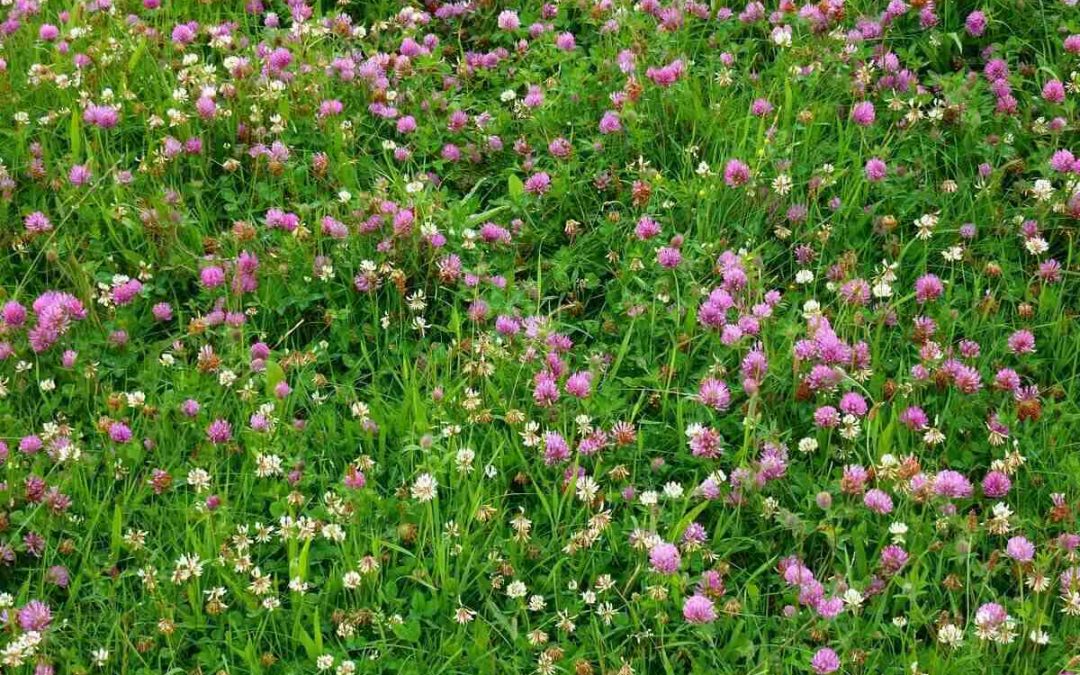Although clover is often thought of as a weed, it belongs to the legume or pea family. Three types of clover species are common across the U.S: white clover, red clover, and strawberry clover.
You’ll learn about these common clover types (and several others) below.
In this article:
What is a Clover Lawn?
A clover lawn is either completely made of clover or combines clover and turfgrass. Clover is a legume from the pea family developed in Europe. Clover arrived in North America in the late 1600s and was a favorite lawn choice until the 1950s when turfgrass gained popularity.
Planting clover in your yard has advantages. Clover requires far less maintenance, conserves water, stays green in the summer, and is an environmentally-friendly grass alternative.
3 Types of Clover Common in Lawns
The common word “clover” refers to a collection of over 300 plants in the Trifolium genus. However, there are three types of clover species commonly used on lawns in the United States.
1. White Clover (Trifolium repens)
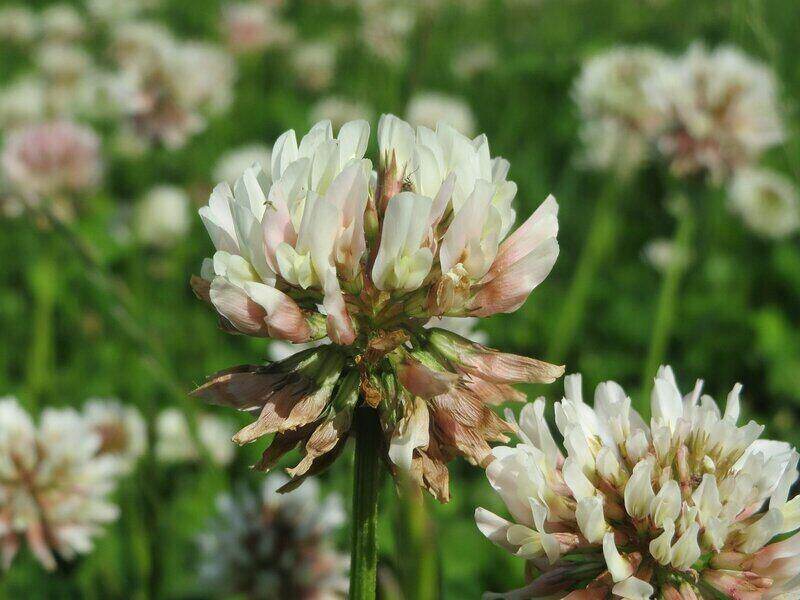
Photo Credit: Pixabay
White clover is the most common variety, sometimes collectively referred to as “Dutch clover” or “Dutch white.” This cool-season perennial is usually seen growing in lawns, vineyards, and by the sides of roadways.
This clover is frequently utilized as a natural treatment to help reduce fever, ease coughs and colds, and strengthen the immune system.
White clover thrives in the cold, rainy conditions of zones 6a-9b. It grows best in well-drained, rich soil with a pH of 6 to 7, and prefers full sun but will tolerate partial shade.
Based mostly on leaf size, white clover has three common variants:
- Ladino (T. repens var. giganteum): With its large leaves, this type is largely used as feed or pastures for livestock.
- Dutch white (T. repens f. hollandicum): Has medium-sized leaves and is often used as a cover crop, ground cover, in pasture blends, in lawns, and to control erosion.
- Wild white (T. repens f. repens): This wild variety is usually seen along roadsides, fields, and lawns. It’s very attractive to grazing wildlife.
- Microclover (T. repens var. “Pirouette” and “Pipolina”): The leaves? You guessed it – tiny. Often blended with turfgrass to increase soil nitrogen and improve lawn development.
White clover has round pink to white blossoms. It blends well with cool-season turfgrasses such as fescues, Kentucky bluegrass, and perennial ryegrass.
2. Red Clover (Trifolium pratense)
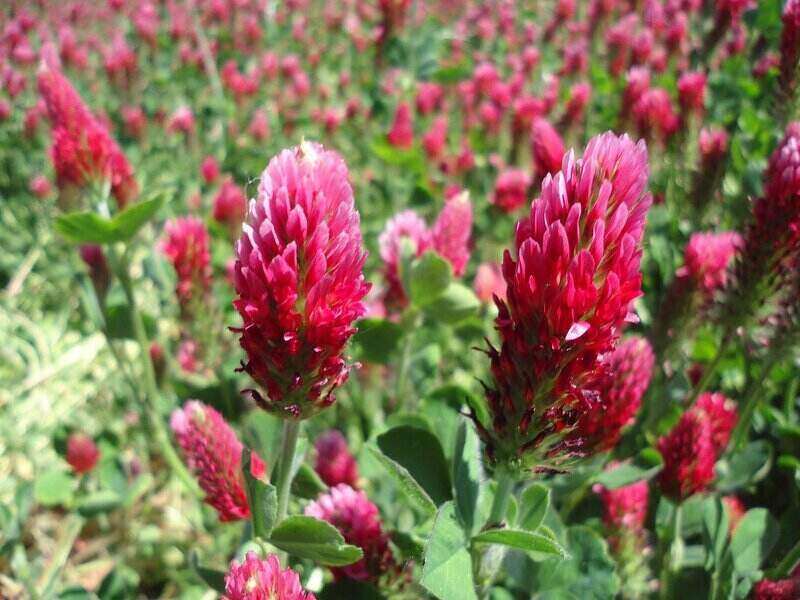
Photo Credit: Pixabay
A perennial herb, red clover grows wild in meadows throughout Europe and Asia but has become established in North America. Cow clover, meadow clover, and wild clover are some of its other names.
Red clover was used in the past to treat a variety of illnesses, including gout, whooping cough, cancer, and asthma. Red clover supplements have been advocated for osteoporosis and menopause symptoms as the isoflavones found in red clover are similar to estrogen.
This clover is resilient in acidic soils but prefers well-drained dirt with a pH between 6.0 and 7.2. It does well in 4a-8b hardiness zones. Red clover is vulnerable to fungi that cause diseases such as stem rot and powdery mildew.
There are two common types of red clover:
- Medium red (Trifolium pratense): The most common variety, is adaptable and easy to grow. Due to its biennial nature, it will grow in the first season and bloom in the next.
- Mammoth red (Trifolium pratense, Mammoth): This type of red clover is a biennial that grows higher than the medium variety. It’s used as a cover crop to prepare the soil for future plantings by adding nitrogen and organic matter.
Red clover blossoms range from magenta to rose. A cool-season ground cover, it has good performance with perennial ryegrass, white clover, sweet clover, or tall fescue. Red clover mixes well in warm-season lawns when planted with Bermudagrass.
3. Strawberry Clover (Trifolium fragiferum L)
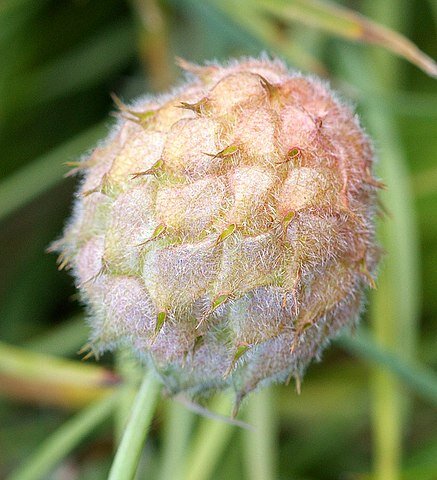
Photo Credit: Christian Fischer / Wikimedia Commons / CC BY-SA 3.0
Strawberry clover is a perennial herb native to the eastern Mediterranean and southern Asia. While it may not grow in regions with excessive heat or cold, it thrives well in almost all types of soil.
Strawberry clover is a good bee plant, but it is rarely used as animal feed because of its short stature. It works well in lawns and permanent pastures. Strawberry clover grows well in hardiness zones 4a-9b and a soil pH between 5.3 and 8.2
The white or pink blooms on strawberry clover are smaller than on white clover. It draws birds of all sizes, does well in cool regions, and can withstand flooding very well. Compared to other types of clover, strawberry clover can withstand more salinity and is a good choice for coastal areas.
Strawberry clover is also a cool-season variation. It partners well with tall fescue, ryegrass, timothy, reed canarygrass, dallisgrass, bermudagrass, and white clover.
4. Lucky Clover
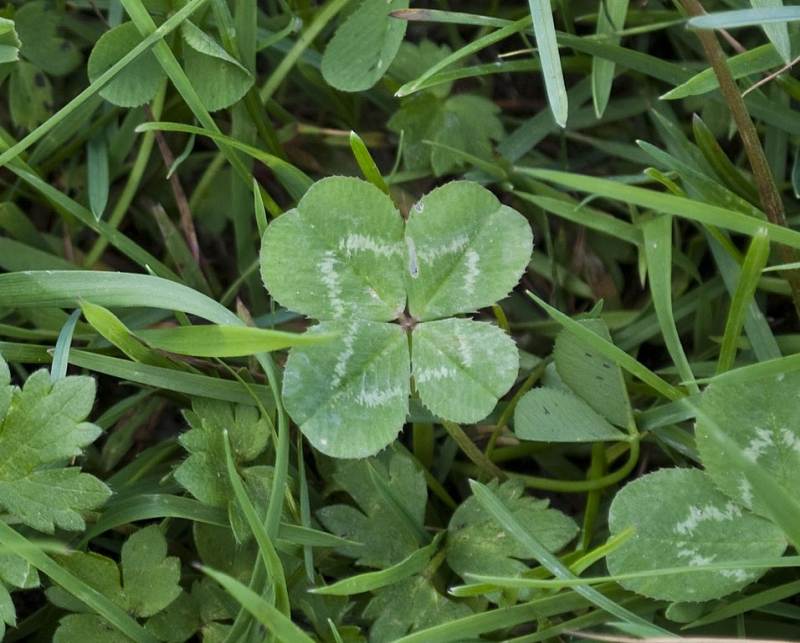
Photo Credit: KEBman / Wikimedia Commons / Public domain
OK, maybe you can’t plant good luck but finding a four-leaf clover might bring it. This belief is probably because there is only one of them for every 10,000 clovers with three leaves.
Some Celtic cultures in the Middle Ages held the belief that holding a four-leaf clover would enable the bearer to see fairies, fend off evil spirits, and bring good luck.
“If a man walking in the fields finds some four-leaved grass, he shall in a brief while after find some good thing,” or so said John Melton in the 1600s.
Even if you never come across one with four leaves, clover will help your grass stay greener for longer while requiring less upkeep, and that’s lucky.
Other Forms of Clover
Farmers who use the plant as a pasture and foraging plant prefer other varieties of clover, especially annuals. Other varieties of clover that aren’t suitable for lawns:
- Arrowleaf clover: Because it may grow up to 4 feet tall, arrowleaf clover isn’t a good choice for residential settings. It’s best for hay, grazing, and wildlife foraging.
- Crimson clover: An annual clover used to lengthen the grazing season for farm animals.
- Alsike clover: A perennial clover related to white clover used in pastures for hay production and grows to be about 1 to 3 feet tall.
- Berseem clover: A summer or winter annual with yellow flowers, also known as Egyptian clover. It grows up to 4 feet tall.
- Subterranean clover: An annual winter clover with white flowers extensively utilized in Oregon and California meadows.
- Rose clover: This winter-annual clover has lavender flowers and crimson clover-like growth. This clover shows up as a cover crop in pastures and vineyards.
Benefits of Clover Lawns
Beautiful to look at, there are benefits to planting a clover lawn.
- Fixes nitrogen levels: With the aid of Rhizobium bacteria, clover converts nitrogen from the air into a usable form for plants.
- Natural weed control: Clover’s ability to out-compete harmful weeds reduces the time, energy, and money it takes to manage weeds in your yard.
- Green manure: The plants add organic matter to the soil when the clover seeds have developed and the roots have decomposed.
- Reduces erosion: Deep taproots help protect the soil and its nutrients from harsh wind, rain, and other natural forces.
- Pet urine resistant: Clover isn’t harmed by dog urine and will remain green when most grasses turn brown.
- Low maintenance: Clover can reduce the need for nitrogen fertilizers, herbicides, and pesticides. It requires less mowing, less water, and is environmentally friendly.
- Stays green: In locations with warm winters, like the southern United States, clover remains green all year. Except in extreme drought, it will retain its color throughout the summer.
A grass-clover lawn can give you the benefits of clover while still being resistant to heavy foot traffic.
Disadvantages of Clover Lawns
Clover is a good option for lawns across the country, but these are disadvantages of clover worth considering.
- Bee allergies: Clover attracts pollinators. It is a favorite of our honeybee and bumblebee friends, which may be problematic if you or a family member is allergic to bees.
- Less durable: If you’re a homeowner with active kids or pets you may want to try blending clover with grass seed to ensure your lawn is more resistant to wear and tear.
- The look: Compared to a traditional grass lawn, clover might be more sparse, bumpy, and irregular.
- Need to re-seed: The amount of reseeding in a pure clover yard will be higher than in a grassy lawn. You’ll need to re-seed every three years.
- Is invasive: Clover will take over nearby garden beds. Place a barrier between your garden and the yard to prevent this.
FAQ About Clover Lawns
1. When should you plant a clover lawn?
Spring and early summer are the best times to plant clover. Clover seeds sprout fastest when temperatures are between 60 and 80 degrees and there is no danger of frost. You can plant clover in late summer or early fall but do so at least six weeks before a hard freeze.
2. Do you need to aerate a clover lawn?
No. Because clover is a living mulch, it supplies the soil with nutrients while also helping it resist compaction. Macropores are left behind in the soil by decomposing clover roots. This keeps the ground loose, draws earthworms, and reduces thatch buildup.
3. Is a clover lawn better than a turfgrass lawn?
That depends. Clover has many advantages, and turfgrass lawns have disadvantages despite their visual appeal. Grass-only lawns deny pollinators of food and habitat and need more water, chemical treatments, and upkeep than a clover lawn does.
If you want to hunt for a lucky four-leaf clover instead of planting them then we can help! We’ll find a lawn care professional near you to roll out the green carpet for your new lawn.
Main photo credit: Pxhere

